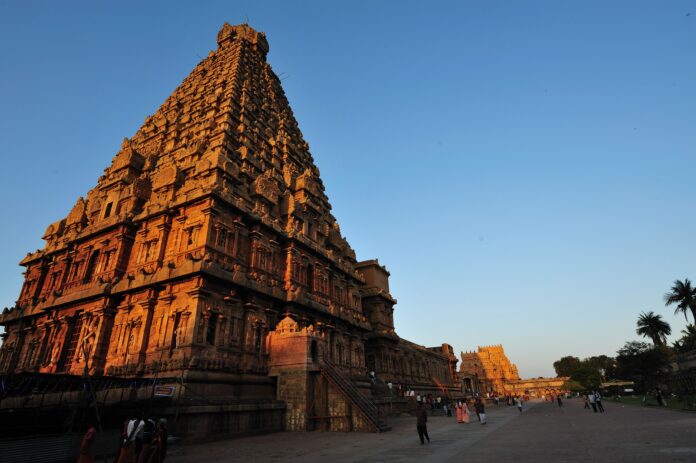Meenakshi Temple, Madurai: The Meenakshi Temple is a prominent Hindu temple located in Madurai, Tamil Nadu. It is dedicated to Goddess Meenakshi, also known as Parvati, and her consort Lord Sundareswarar, an incarnation of Lord Shiva. The temple is renowned for its magnificent architecture, especially the towering gopurams (entrance towers) that are adorned with intricate sculptures depicting various mythological stories. The complex covers an area of about 15 acres and includes numerous halls, shrines, and courtyards. The Thousand Pillar Hall, with its intricately carved pillars, is a major attraction within the temple. The annual Meenakshi Tirukalyanam festival, celebrating the celestial wedding of the deities, attracts thousands of devotees and tourists.
Kedarnath Temple, Uttarakhand: Situated in the breathtaking Kedarnath town in Uttarakhand, Kedarnath Temple is one of the twelve Jyotirlingas (sacred abodes of Lord Shiva) in India. Perched amidst the majestic Himalayan peaks, the temple is located at an altitude of 3,583 meters (11,755 feet), making it one of the highest temples in the country. The temple is believed to have been constructed by the Pandavas from the Hindu epic Mahabharata. It is a place of immense spiritual significance and is visited by millions of pilgrims every year, especially during the Chardham Yatra season. The temple’s stone architecture, surrounded by breathtaking natural beauty, creates a tranquil and awe-inspiring ambiance for devotees.
Brihadeeswarar Temple, Thanjavur: The Brihadeeswarar Temple, also known as the Peruvudaiyar Kovil or Big Temple, is located in Thanjavur, Tamil Nadu. Built by the Chola king Raja Raja I in the 11th century, it is considered a masterpiece of Dravidian architecture. The temple is dedicated to Lord Shiva and features an enormous vimana (temple tower) that stands at around 66 meters (216 feet) tall. The temple complex showcases exquisite sculptures, including the famous Nataraja sculpture, and intricate frescoes depicting various mythological scenes. The temple’s grandeur, architectural precision, and cultural significance led to its inclusion as a UNESCO World Heritage site.
Golden Temple, Amritsar: The Golden Temple, officially known as Sri Harmandir Sahib, is the most revered Sikh Gurudwara (place of worship) situated in Amritsar, Punjab. It is a symbol of the Sikh faith and serves as a spiritual and cultural center for the Sikh community worldwide. The temple is known for its striking golden exterior, which is a result of gold plating over its dome and parts of the upper structure. The temple complex also features a sacred pool called the Amrit Sarovar, where pilgrims take part in a ritualistic bathing known as “Sarovar Seva.” The Guru Granth Sahib, the holy scripture of Sikhism, is recited continuously inside the temple. The Golden Temple’s architectural beauty, serene atmosphere, and the principles of equality and service offered within its premises make it a significant religious and cultural landmark.
Akshardham Temple, Delhi: Akshardham Temple, located in New Delhi, is a modern architectural marvel and a major tourist attraction. Constructed in 2005, the temple complex showcases traditional Indian art, architecture, and spirituality. It is dedicated to Bhagwan Swaminarayan and his teachings. The temple features intricate carvings, domes, and ornate pillars, all crafted by skilled artisans. The complex also includes beautifully landscaped gardens, exhibitions depicting India’s ancient culture and traditions, a boat ride showcasing the country’s historical events, and an evening musical fountain show. Akshardham Temple stands as a testament to India’s rich heritage and spiritual values.
Sun Temple, Konark: The Sun Temple in Konark, Odisha, is an architectural marvel and a UNESCO World Heritage site. Built in the 13th century, the temple is dedicated to the sun god Surya. It is designed in the shape of a colossal chariot, with intricately carved stone wheels and walls. The temple’s walls are adorned with intricate sculptures and carvings, depicting various aspects of life, mythology, and religious beliefs. The temple’s main sanctum, originally housing a gigantic statue of the sun god, is now in ruins, but its architectural grandeur and artistic detailing continue to captivate visitors. The Sun Temple represents the rich cultural and artistic heritage of ancient India.
Meenakshi Amman Temple, Rameswaram: Situated in Rameswaram, Tamil Nadu, the Meenakshi Amman Temple is a renowned pilgrimage site dedicated to Goddess Meenakshi, an avatar of Parvati. The temple complex is an architectural marvel, featuring intricately carved pillars, gopurams, and shrines. The 1,000-pillar hall, adorned with intricate sculptures and paintings, is a striking feature of the temple. The temple attracts devotees and tourists who seek blessings and spiritual solace. Rameswaram itself holds great religious significance as it is believed to be the place where Lord Rama built a bridge to Lanka, as mentioned in the Hindu epic Ramayana.
These temples represent the rich cultural, architectural, and religious heritage of India and continue to be revered and visited by devotees and tourists from around the world.




